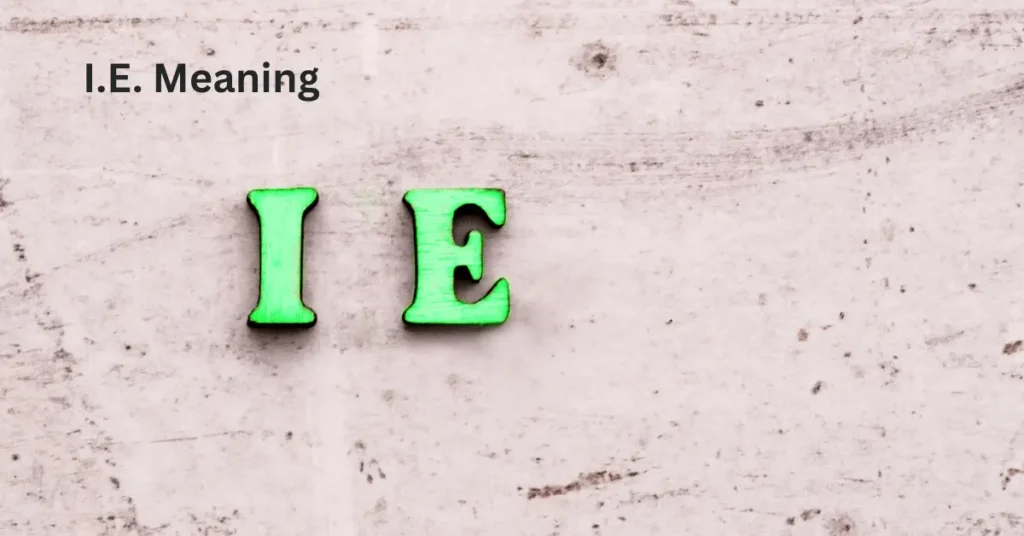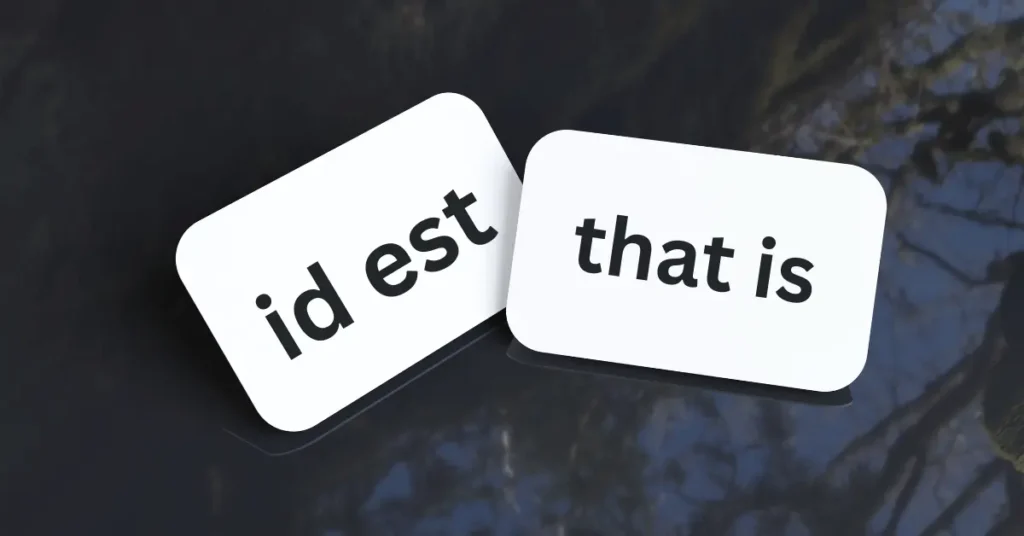I.E. Meaning

Have you ever come across the abbreviation “i.e.” and wondered what i.e. meaning is? If so, you’re not alone! The term “i.e.” is often used in writing to clarify or explain something more clearly.
It stands for “id est,” a Latin phrase that translates to “that is” or “in other words.”
In this blog post, we’ll dive into the meaning of “i.e.,” its history, and how you can use it correctly in your writing.
Whether you’re writing an email, an essay, or just curious about how to communicate more effectively, understanding “i.e. meaning” is a helpful skill. Let’s explore it together!
What Does “i.e.” Mean?
The abbreviation i.e. stands for the Latin phrase (id est), which directly translates to (that is) or in other words.
It’s used in writing to introduce a clarification or a more specific explanation of something mentioned earlier in the sentence. Essentially, “i.e.” helps you to restate something in a way that is more precise or clearer.
When you see “i.e.” in a sentence, think of it as a signal that the following information will further define or specify what was just said.
It’s like giving your reader a more focused, refined version of your initial point. For example:
“I love tropical fruits, i.e., fruits that grow in warm climates like pineapples and mangoes.”
In this case, “i.e.” is used to specify exactly what “tropical fruits” means. It’s a way to elaborate on the previous statement and make sure the reader understands exactly what you’re talking about.
How It’s Different from “e.g.”
Many people confuse “i.e.” with “e.g.,” but they serve different purposes.
While “i.e.” is used to clarify or specify, “e.g.” stands for exempli gratia, which means “for example.” “E.g.” introduces examples of a broader concept, rather than explaining or defining it. So, remember:
“i.e.” = “that is” (clarification)
“e.g.” = “for example” (illustration)
In summary, “i.e.” is a helpful abbreviation to use when you want to make your point clearer and provide an exact meaning or description.
It’s a simple way to add precision to your writing without needing to elaborate endlessly.
“i.e.” Meaning – Definition
Definition
As mentioned earlier, “i.e.” is an abbreviation for the Latin phrase id est, which translates to “that is” or “in other words.”
It’s used in writing to clarify, specify, or restate something in a more precise manner.
Essentially, when you use “i.e.,” you’re giving a more exact definition or explanation of something you’ve just mentioned.
You can think of “i.e.” as a tool for providing more detail and narrowing down a concept or term.
It helps you define your statement further by offering a more specific meaning, removing ambiguity, and making sure the reader understands exactly what you mean.
Examples of “i.e.” in Sentences
Example 1:
“I enjoy reading classic novels, i.e., books written in the 19th and early 20th centuries.”
In this example, “i.e.” is used to clarify what “classic novels” refers to, specifically books from a certain time period.
Example 2:
“She prefers outdoor sports, i.e., activities like hiking, cycling, and rock climbing.”
Here, “i.e.” is helping to specify which kinds of outdoor sports the person enjoys by providing examples.
Example 3:
“The company focuses on renewable energy sources, i.e., wind, solar, and hydroelectric power.”
“i.e.” in this sentence defines exactly what “renewable energy sources” means by listing the specific types.
Example 4:
“John is a vegetarian, i.e., he does not eat meat or fish.”
In this case, “i.e.” is used to provide a more specific explanation of what being a “vegetarian” involves.
Example 5:
“Her favorite genre is mystery, i.e., books or movies with suspenseful, puzzling plots.”
“i.e.” helps to further explain what “mystery” as a genre entails by providing a detailed definition.
Why Use “i.e.”?
Using “i.e.” is an effective way to ensure that your reader clearly understands a concept or term.
It’s especially useful in academic writing, professional communication, or any context where precision is key. Instead of leaving room for interpretation or misunderstanding, “i.e.” allows you to directly clarify your meaning.
In simpler terms, whenever you want to narrow down or specify what you’re talking about, “i.e.” is your go-to abbreviation.
Word Origin of “i.e.”

The abbreviation “i.e.” comes from the Latin phrase id est, which translates to “that is” or “in other words.”
To understand the origins of “i.e.,” it’s helpful to break down its Latin roots and how it has evolved over time into the abbreviation we use today.
Latin Roots
“Id”: In Latin, “id” means “it” or “that,” referring to something specific.
“Est”: The Latin verb “est” means “is” (the third person singular form of “to be”).
Together, id est literally means “that is” or “it is,” and it’s used to introduce a further explanation or clarification of a statement.
How It Became “i.e.”
Over time, id est was shortened into the two-letter abbreviation “i.e.” for convenience, especially in written form.
This abbreviation gained popularity in scholarly, academic, and formal writing, where clarity and precision are essential.
Using the shortened version of id est made it quicker to clarify or specify a point without writing the full Latin phrase every time.
While “i.e.” is derived from a Latin phrase, its use in modern English writing is widespread. It’s used to introduce a more precise or exact explanation, serving as a bridge to further detail the concept or term mentioned earlier.
Evolution into English Usage
The use of Latin phrases like i.e. in English became more common during the Renaissance period, when Latin was widely taught and used in academic and intellectual circles.
As English evolved, many Latin abbreviations, including i.e., became fully integrated into everyday language, especially in written communication.
Latin was seen as the language of scholarship and formal documentation, which is why many such phrases have persisted in professional and academic writing.
Today, “i.e.” is firmly entrenched in English grammar and is used frequently in both formal and informal contexts, making it an essential tool for writers who want to provide clarity and precision.
FAQs
What does “i.e.” mean?
“I.e.” is an abbreviation for the Latin phrase id est, which translates to “that is” or “in other words.” It’s used in writing to clarify or specify something in more detail. When you see “i.e.,” it signals that the writer is about to provide a more precise explanation or definition of a concept mentioned earlier in the sentence.
How is “i.e.” different from “e.g.”?
While “i.e.” and “e.g.” are both used to provide more information, they serve different purposes:
“i.e.” means “that is” or “in other words,” and it’s used to define or clarify something more precisely.
“e.g.” means “for example” and is used to introduce a few examples of a broader concept. For example:
“I enjoy outdoor activities, i.e., hiking, biking, and swimming.” (Here, you are defining exactly what you mean by “outdoor activities.”)
“I enjoy outdoor activities, e.g., hiking, biking, and swimming.” (Here, you are giving a few examples of outdoor activities but not defining them exactly.)
Can I use “i.e.” in informal writing?
Yes, you can use “i.e.” in informal writing, though it’s more commonly found in formal or academic writing. It’s a great way to provide clear explanations or clarify terms in any type of communication. However, in very casual conversations or texts, you might want to use simpler words like “that is” instead of “i.e.” for clarity.
Is “i.e.” always followed by a comma?
Yes, when using “i.e.” in a sentence, it is typically followed by a comma to separate the abbreviation from the clarification that follows. For example:
“She loves classical music, i.e., symphonies and operas.” However, in some cases (especially in technical or formal writing), you might see “i.e.” used without a comma, though the comma is the more common convention.
Can I use “i.e.” to provide examples?
No, “i.e.” is not used to provide examples. If you want to introduce examples, you should use “e.g.” instead. “I.e.” is used to give a precise definition or explanation of something. For example:
Correct: “My favorite fruits are citrus, i.e., oranges, lemons, and limes.” (You’re explaining exactly what you mean by “citrus.”)
Incorrect: “My favorite fruits are citrus, i.e., oranges, lemons, and limes.” (This would be a case for “e.g.” instead, since you’re providing examples, not a strict definition.
Conclusion
In summary, “i.e.” is a helpful abbreviation that stands for the Latin phrase id est, meaning “that is” or “in other words.”
It’s used to clarify or provide a more precise explanation of something you’ve mentioned earlier. Whether you’re writing formally or informally, using “i.e.” can make your points clearer and more specific.
Just remember, it’s different from “e.g.” which introduces examples, while “i.e.” gives exact definitions or explanations. With this knowledge, you’ll be able to use “i.e.” confidently in your writing!
Extra Points on “i.e.”
- A Quick Shortcut: “i.e.” is a great shortcut to make your writing more efficient. Instead of repeating a long explanation, you can simply use “i.e.” to define or clarify your point. It saves time and makes your sentences clearer.
- Used for Precision: Whenever you want to be extra clear or specific, “i.e.” comes to the rescue. It’s perfect for situations where you need to narrow down a broad term or concept to something very particular.
- Common in Academic Writing: You’ll often find “i.e.” used in academic papers, research articles, and textbooks. It’s a standard abbreviation in formal writing because it helps present complex ideas in a precise way.
- Don’t Overuse It: While “i.e.” is helpful, be careful not to overuse it. Relying on it too much can make your writing feel repetitive. Use it when it really adds clarity to your point.
- Pronunciation: When speaking, most people pronounce “i.e.” as “eye-ee.” Though it’s an abbreviation, it’s still good to know how to say it correctly if you ever need to mention it in conversation.